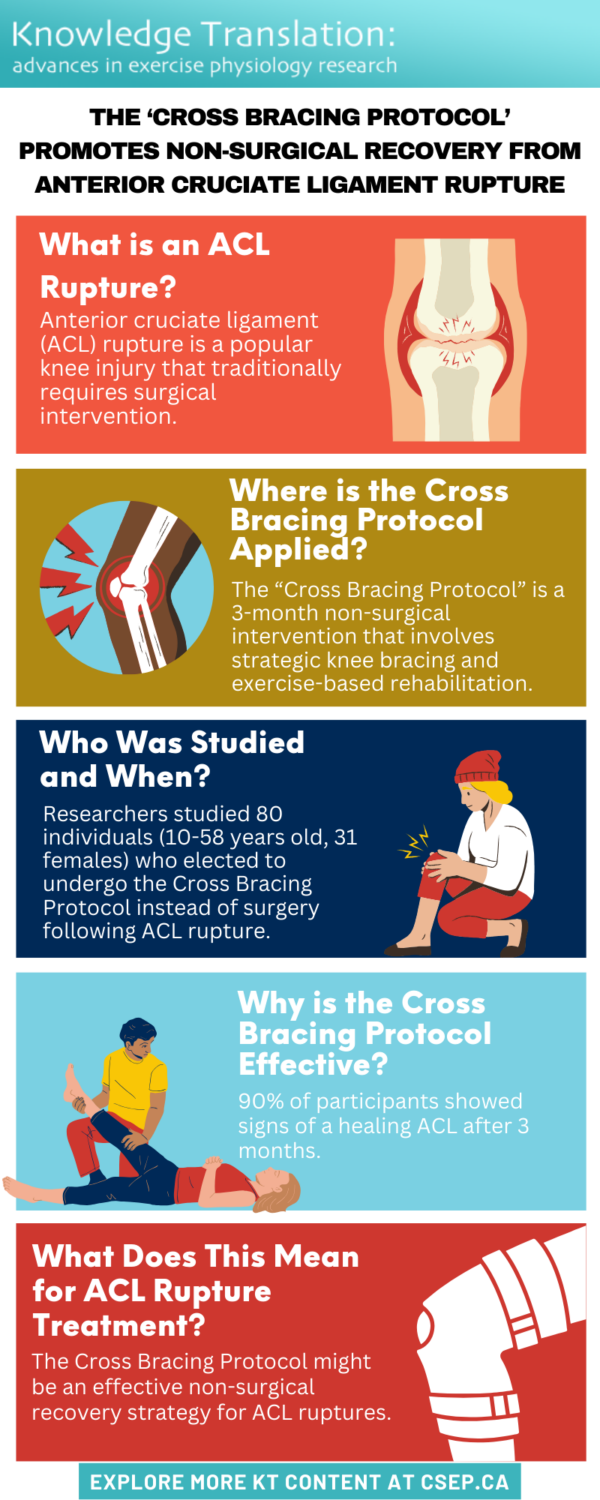May 2024
Author’s credentials.
Adrian Betts.
Bachelors Clinical Exercise Physiology. Master in Mental Health (B.Cl.Ex.Phys, MA in Mental Health)
Affiliation: The Canadian Society for Exercise Physiology (CSEP)
Reference:
Filbay, S. R., Dowsett, M., Jomaa, M. C., Rooney, J., Sabharwal, R., Lucas, P., Heever, A. V. D., Kazaglis, J., Merlino, J., Moran, M., Allwright, M., Kuah, D. E. K., Durie, R., Roger, G., Cross, M., & Cross, T. (2023). Healing of acute anterior cruciate ligament rupture on MRI and outcomes following non-surgical management with the Cross Bracing Protocol. British Journal of Sports Medicine, 57(23), 1490-1497.

Take home message
The anterior cruciate ligament (ACL) demonstrates the potential to repair itself from a complete tear if the right conditions are met, such as the torn ends remaining near one another, and motion of the knee is reduced post-injury.
- The Cross Bracing Protocol (CBP) increases healing likelihood by immobilizing the knee at 90 degrees of flexion for a set time, and then slowly and progressively increasing the range of allowed motion over 12 weeks.
- This protocol offers an effective non-surgical method to heal the ACL and return to pre-injury sport and knee function.
Background
- Studies have shown, contrary to popular belief, that a ruptured (ACL) can heal itself.
- A problem occurs in the healing process if the ruptured sites of the ACL are placed too far away from one another, impairing the ability of new tissue to bridge the gap.
- When the knee is at 90 degrees of flexion, the ACL origin and insertion points are at their closest to one another, offering greater potential for new tissue to heal the damaged ACL.
How the study was done
- 80 individuals, 31 females and 49 males, aged 10 to 58 years with a mean age of 26 years participated.
- The patient’s ACL rupture was confirmed by magnetic resonance imaging (MRI) and were accepted if they presented within 4 weeks of rupture and were functionally capable of managing the period of knee immobilization.
- Patients were excluded from CBP if structural injuries required surgical intervention.
- Patients were offered the Cross Bracing Protocol, early ACL reconstruction (ACLR), or non-surgical rehabilitation with optional delayed ACLR. Of 117 patients, 80 chose CBP, 5 were ineligible for CBP, and 32 chose early ACLR due to an ACL rupture type that risked a suboptimal outcome, or from personal reasons such as sporting professional needs and private insurance access.
- The 12-week protocol involved bracing the knee at 90 degrees of flexion for the first 4 weeks and then progressively increasing the range of motion within the brace.
- Participants completed a rehabilitation protocol during the same period that involved manual therapy, strengthening, and gait retraining.
- Outcomes measured were ACL healing evident by MRI results (3 & 6 Months), self-reported knee function (7-16 months), knee-related quality of life (7-16 months), passive knee laxity: Lachman’s test (3 months) and pivot- shift test (6 months), and self-reported return to pre-injury sport at 12 months.
What the researchers found
- At a 3-month follow-up, 90% (n=72) of participants demonstrated a continuous ACL and a grading of 1 or 2 (0 = normal ligament; 3 = absent ligament or complete discontinuity). 8 participants had a grading of 3, including 6 participants with an ACL attached to the lateral wall or posterior cruciate ligament.
- Grade 1 was associated with improved quality of life, better knee function, an improved likelihood of returning to sport, and reduced laxity at the knee.
- 11 participants sustained an ACL reinjury between 5-18 months during their return to sport, of which one opted for CBP again resulting in a grade 1, while 9 participants opted for surgical reconstruction.
- 5 participants completing the CBP experienced contralateral limb overuse injuries upon brace removal, such as pes anserine bursitis, hamstring tendinopathy, and patellofemoral pain.
Conclusion
The ACL has the potential to heal if treated within the first 4-weeks post-injury. The CBP assists this healing process by bringing the ACL tissue to its closest points and progressively increasing this to normal range of motion. This protocol demonstrates an effective non-surgical method to heal the ACL and return to pre-injury sport.
